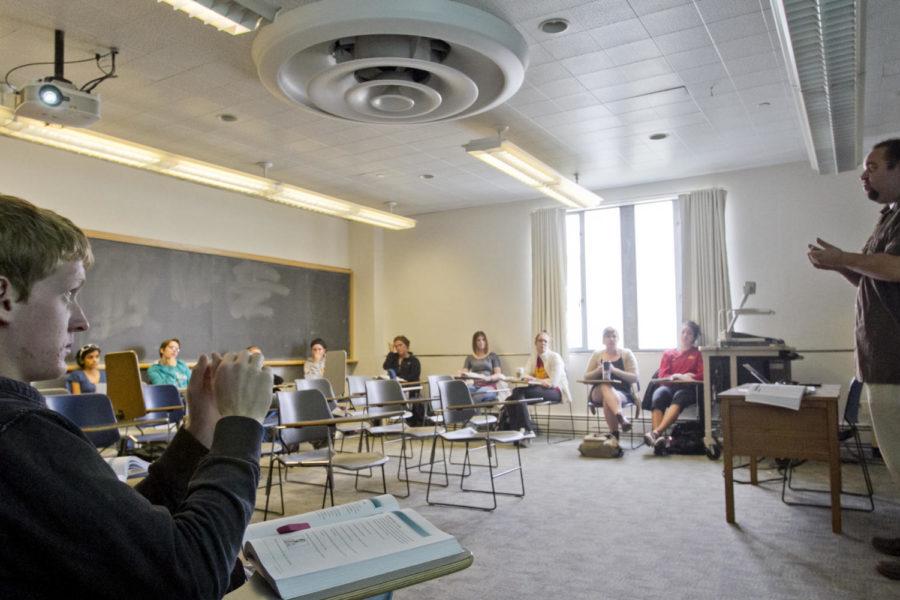American Sign Language course offers better understanding of communication
October 5, 2012
Being comfortable with your body provides for better learning abilities when it comes to American Sign Language, according to Jonathan Webb, ASL instructor and interpreter and lecturer in world languages and cultures. This fall is the first semester that ASL courses have been offered on campus at Iowa State, and the demand to learn is expected to grow.
“From what I understand, there’s been talk of offering American Sign Language here for 20 years,” Webb said. “With the advent of American Sign Language being offered, with kind of some crystal ball gazing, we’re assuming this program is going to grow. It’s going to flourish and it’s going to possibly offer some career choices to some individuals.”
Webb said that like all basic language courses, ASL 101 is based on conversation and giving someone a basic communication ability.
“People can expect a rigorous class,” Webb said. “There is still this pervasive idea out there that ‘Oh, ASL will be easier to learn than other spoken languages.’”
Although no studies have been done, Webb suspects that for students who are coordinated with their hands, ASL will come more naturally.
“It really comes down to: Are you able to process and use a visual language? Can you kind of whiten out or ‘turn off’ temporarily that part of your brain that says language has to be linear and it has to be audible?” Webb said. “[Can you] move into a place where language cannot just be linear, but three-dimensional, and where it’s not audible, but it’s actually visual?”
Tiffany Bosse, freshman in kinesiology and health, loves the course and being able to practice and understand the language with classmates.
“When [classmates] see each other on campus, we will use some signs, and we will start laughing because we know what the other person is saying,” Bosse said.
ASL courses use a variety of different methods to test students on their knowledge. The midterm, for example, is divided into three components. A written portion will be given to test students on the structure of ASL and its history. An expressive portion must be completed where students video tape themselves signing their autobiography. The third portion tests reception of the messages given by Webb with a series of stories told to students who listen and answer questions.
Webb spends 60 percent of his time teaching and 40 percent of his time interpreting for students through Student Disability Resources.
“Minority groups tend to go where they feel comfortable, and part of the reason why this position has been established with Student Disability Resources is because they want deaf individuals to feel comfortable coming to campus,” Webb said.
Webb hopes that ASL eventually becomes its own major at Iowa State and provides a chance for teaching careers to expand the knowledge of the language.
“There’s nothing that’s been decided, but there is talk of a major in American Sign Language,” Webb said. “There’s talk of interpreter education taking place here, where individuals will become fluent in the language and then be educated and trained in the process of actually simultaneously interpreting between English and ASL.”
Alejandro “Alec” Barnum-Luna, freshman in linguistics, said as an active learner, he enjoys being able to use his hands to communicate.
“I’m thinking about switching this to my major once they build it to sign language interpretation or something. I love working with my hands, and being involved and using [ASL],” Barnum said.
Among many misconceptions about sign language, Webb said, one of the most common is that ASL is universal.
“If I was to go to France, I would be able to communicate with deaf people fairly well, but if I was to go to England, where our spoken languages are shared, I wouldn’t be able to communicate with them,” Webb said.
According to SignGenius.com, an ASL website, sign language was not established in America until the mid-18th century when Thomas Hopkins Gallaudet traveled to Europe to visit a sign language institution in Paris and met Laurent Clerc, a recent French deaf school graduate. Together the two developed a sign language that would be better suited to Americans.
Alicia Galloway, senior in environmental science, said the class has expanded her view on communication.
“Just being able to see the concept of something versus just the meaning of the word and visualizing things more,” Galloway said. “I pay more attention to people’s body language now.”







